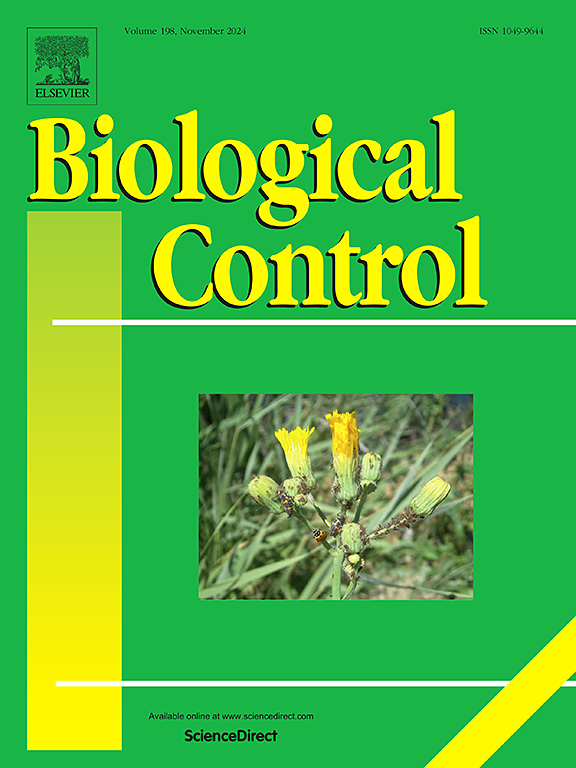非洲织蚁是否可以作为昆虫病原真菌的媒介来加强对伤寒果蝇害虫的生物控制?
IF 3.7
2区 农林科学
Q2 BIOTECHNOLOGY & APPLIED MICROBIOLOGY
引用次数: 0
摘要
昆虫驱虫是一种环境友好型的害虫防治策略,昆虫作为生物杀灭剂的精确载体,通过传播来瞄准害虫种群。虽然大黄蜂是唯一用于商业目的的昆虫,但其他昆虫物种,包括蚂蚁,提供了未开发的潜力。树栖编织蚁(Oecophylla longinoda)在生产作物中具有有益的捕食作用,可以作为昆虫病原真菌绿僵菌(Metarhizium anisopliae)的载体,以加强对入侵东方果蝇背小实蝇(Bactrocera dorsalis)的控制。在本研究中,我们在实验室和环境条件下进行了一系列实验,以探讨这种蚂蚁作为昆虫昆虫的可行性。结果表明,虽然绿僵菌对织蚁具有内在致病性,但织蚁能够检测到其存在,并根据其浓度调整行为。尽管暴露在外,蚂蚁通过社会免疫行为有效地保护了自己。此外,编织蚁通过在污染区域行走,将分生孢子接种到自己身上,随后将分生孢子散布在它们的足迹上。虽然分散的分生孢子的密度随着时间和距离接种区而下降,但当果蝇在被编织蚁传播分生孢子的芒果树上漫游时,高达36%的果蝇被杀死。虽然将织工蚁作为害虫昆虫与其他策略相结合可以加强害虫果蝇的控制,但在现场应用之前还需要克服几个挑战。本文章由计算机程序翻译,如有差异,请以英文原文为准。

Can the African weaver ant be used as a vector of entomopathogenic fungi to bolster the biological control of tephritid fruit fly pests?
Entomovectoring is an environmentally friendly pest control strategy where insects act as precision vectors of a biocide to target pest populations through phoretic dispersal. While bumblebees are the only insects used commercially for this purpose, other insect species, including ants, offer untapped potential. The arboreal weaver ant, Oecophylla longinoda, known for its beneficial predatory role in production crops, could be used as a vector of the entomopathogenic fungus, Metarhizium anisopliae to bolster control of the invasive oriental fruit fly Bactrocera dorsalis. In this study, we set up a series of experiments under laboratory and mesocosm conditions to investigate the feasibility of using this ant as an entomovector. Results showed that while M. anisopliae was intrinsically pathogenic to the weaver ants, they were able to detect its presence and adjust their behavior according to its concentration. Despite exposure, the ants effectively protected themselves through social immunity behaviors. Furthermore, weaver ants auto-inoculated themselves with conidia by walking over contaminated areas and subsequently dispersed conidia along their trails. Although the density of dispersed conidia declined over time and distance from the inoculation zone, up to 36% of fruit flies were killed when left to roam on mango trees where conidia had been disseminated by the weaver ants. While the integration of weaver ants as pathogen entomovectors could enhance pest fruit fly control when combined with other strategies, several challenges are yet to overcome before field applications.
求助全文
通过发布文献求助,成功后即可免费获取论文全文。
去求助
来源期刊

Biological Control
生物-昆虫学
CiteScore
7.40
自引率
7.10%
发文量
220
审稿时长
63 days
期刊介绍:
Biological control is an environmentally sound and effective means of reducing or mitigating pests and pest effects through the use of natural enemies. The aim of Biological Control is to promote this science and technology through publication of original research articles and reviews of research and theory. The journal devotes a section to reports on biotechnologies dealing with the elucidation and use of genes or gene products for the enhancement of biological control agents.
The journal encompasses biological control of viral, microbial, nematode, insect, mite, weed, and vertebrate pests in agriculture, aquatic, forest, natural resource, stored product, and urban environments. Biological control of arthropod pests of human and domestic animals is also included. Ecological, molecular, and biotechnological approaches to the understanding of biological control are welcome.
 求助内容:
求助内容: 应助结果提醒方式:
应助结果提醒方式:


